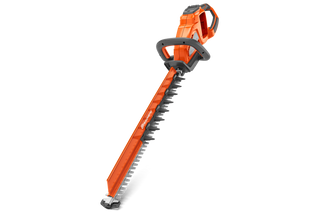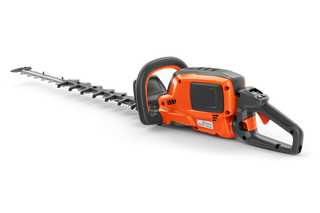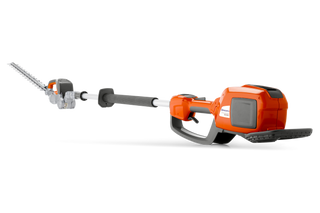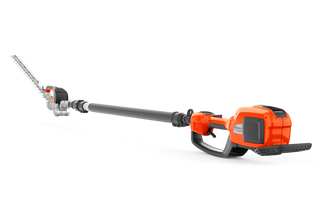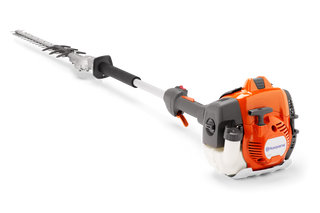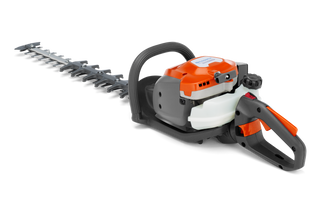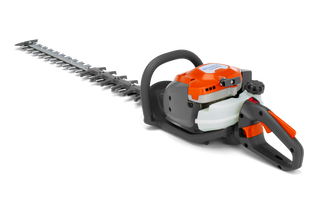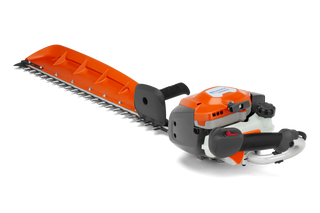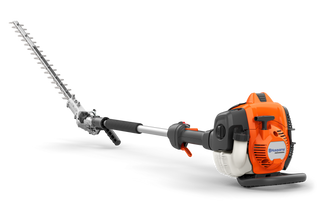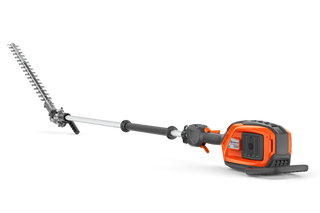Hedge trimmer maintenance
If you want your Husqvarna hedge trimmer to last, you need to maintain them. That means regular care, cleaning, servicing and proper storage.
Components like the blades, engine, air filter, and hand grips all need regular attention.
Clean the cutting blades
Every time your hedge trimmer cuts its way through leaves and small branches, trace amounts of sap begins to accumulate on the blades. Over time, this can cause the blades to bind up, reducing the efficiency of the cut. Not only do dirty blades reduce cutting performance, but the added friction can cause the engine to begin to overheat.
Cleaning hedge trimmer blades is as simple as wiping them down with soapy water and a cloth after each use. Applying a lubricant to the blades after cleaning them is also recommended. Ensure that the blades are thoroughly dry before storing the tool away.
Clean the air filter
For your petrol hedge trimmer's engine to function properly, it needs a constant flow of clean, cool air. When you use your hedge trimmer, debris and dust particles begin to build up in the filter and reduce the airflow, which results in a lack of engine power, poor performance and overheating.
Usually, the air filter is released via a catch or button. Once you have removed the filter, gently blow through it and tap it on a solid surface. If it's very dirty, its best to replace it with a new one.
How to clean or replace the air filter on your hedge trimmer
Clean the spark arrestor
Spark arrestors are screens that limit the size of particles sometimes found in the exhaust gases of outdoor power equipment.
The idea is that by limiting the size of the exhaust particles (piece of carbon or other small debris), the thermal mass of the particle can be made small enough that it is no longer considered a substantial threat of fire hazard.
Care still needs to be taken of the surrounding area to ensure safety of the user and the surrounding environment.
Spark arrestor maintenance
- Examine the muffler for defects and damages.
- Make sure that the muffler is correctly attached to the product.
- If your product has a special spark arrestor scree, clean the spark arrestor screen weekly.
- Spark arrestor is located on the muffler. Remove the cover and once it is off, remove the spark arrestor.
- When inspecting it, make sure the spark arrestor is intact and there are no rips and holes in it. Also, make sure there is no excessive carbon build-up. If there is any carbon build-up it will make your hedge trimmer run at a lower RPM and the product will not breath well.
- Clean the carbon build-up from the spark arrestor with the wire brush.
- Once the spark arrestor is clean, put it back in place.
NOTE: Do not remove the muffler from the product.
Husqvarna recommends that after every 50 hours of operation, the spark arrestor is cleaned.
NOTE: Not every hedge trimmer model has a spark arrestor. Check your product's operator's manual for more information.
Sharpen the hedge trimmer blades
Like any cutting tool, every time your blades cut the foliage, they gradually, over time, become blunt.
You can sharpen the hedge trimmer blades using a small cone-shaped filling stone or a flat file. Limit your blade sharpening to once per every 50-hours of accumulated use and go gently to avoid wearing away too much metal.
Keep the gear greased
In order to prevent moisture entering your hedge trimmer, make sure that the gear housing is lubricated properly. Lubrication is done by adding the grease through the grease nipple on the product.
Always use Husqvarna special grease.
Tighten any loose screws or fittings
Loose parts can easily fall off, become lost, or cause damage to the rest of the tool. The vibrations that a hedge trimmer produces can cause screws, bolts and connectors to loosen over time.
Using the appropriate screwdrivers and spanners, firmly but gently tighten all visible parts and fasteners. Do not overtighten them as this can damage the thread and the surrounding parts.
Lubricate the blades regularly
The more you use your hedge trimmer, the more exposure to moisture and contaminants the blade receive. It is surprising just how quickly erosion can set in and a good lubrication every month will help provide a protective barrier. The lubrication also helps the blades glide over each other smoothly, resulting in less friction and more cutting power.
It is best to lubricated blades after they have had a good wipe down and dry off.
Keep the exterior clean
Buttons, springs, switches, screws and adjusters can all fall victim to poor maintenance if your hedge trimmer is not kept clean. A poorly kept hedge trimmer can run hot as cool air won't be able to flow freely over the engine.
A simple wipe down with a lightly damp cloth or sponge will do the trick. If you have access to one, use gentle compressed air to blow up build up dirt. Avoid using abrasive chemicals and cleaning solutions and keep the rubbing action gentle. After wiping down all the external surfaces, dry it off properly ready for storing until the next use.
Store it correctly
If you store your garden tools in a shed or tool box or on your vehicle that is excessively damp or prone to leaks, you are almost guaranteeing to shorten its lifespan. Moisture will cause metal parts to corrode. The fuel system may become contaminated. And if your hedge trimmer is battery driven, it may result in electrical shorts and electrical component failures.
A waterproof and UV resistant canvas case is a great way to protect your hedge trimmer. You can also wrap your tool in a cotton sheet or towel, placed in a plastic bag and stored in a box off the floor.

